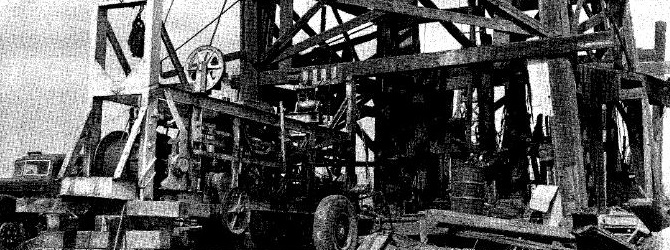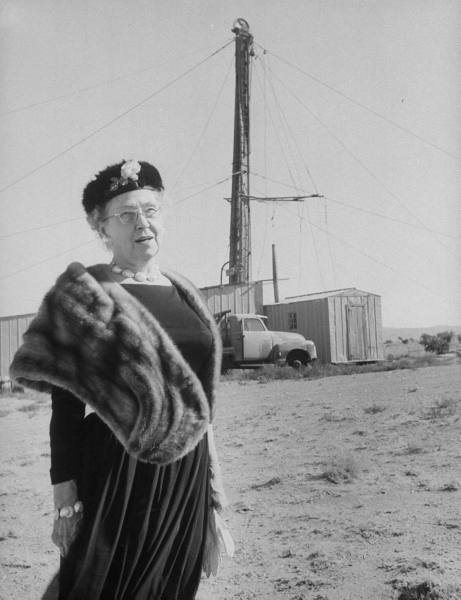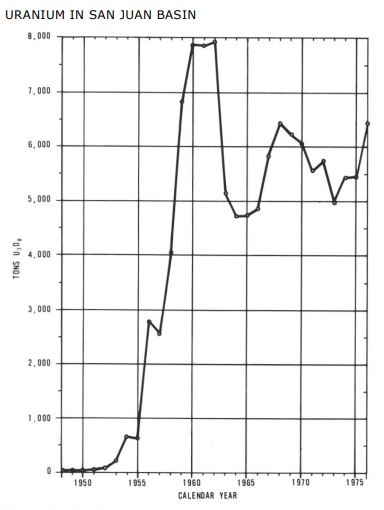Dysart subdivided her properties and subdivided again — selling one-eighth acre leases and oil royalties as small as one-six thousandth to investors. She drilled nothing but dry holes for years. Then it got worse,

Before her good fortune from uranium, Stella Dysart served 15 months in prison for unauthorized selling of New Mexico oil leases. In 1941, she had promoted her Dysart No. 1 Federal well, above, which was never completed.
A 1937 Workmen’s Compensation Act judgment against Dysart’s New Mexico Oil Properties Association bankrupted the company, compelling sale of its equipment, “sold as it now lies on the ground near Ambrosia Lake.”
Two years later, it got worse again. Dysart and five Dysart Oil Company co-defendants were charged with 60 counts of conspiracy, grand theft and violation of the corporate securities (act) in 1939. All were convicted, and all did time. Dysart served 15 months in the county jail before being released on probation in March 1941.
Richest Uranium Deposit
By 1952, 74-year-old Dysart was $25,000 in debt when she met uranium prospector Louis Lothman, a young Texan just two years out of college with a geology degree.
When Lothman examined cuttings from a Dysart dry hole in McKinley County in 1955, he got impressive Geiger counter readings. The drilling of several more test wells confirmed the results. Dysart owned the world’s richest deposit of high-grade uranium ore.
The uranium discovery launched an intensive exploration effort that led to development of the multi-million-ton deposits in the Ambrosia Lake area, according to William L. Chenoweth of the U.S. Energy Research and Development Administration.
“The San Juan Basin of northwest New Mexico has been the source of more uranium production than any other area in the United States,” he noted in a New Mexico Geological Survey 1977 report, “Uranium in the San Juan Basin.”
Dysart was 78 years old when the December 10, 1955, LIFE magazine featured her picture, captioned: “Wealthy landowner, Mrs. Stella Dysart, stands before abandoned oil rig which she set up on her property in a long vain search for oil. Now uranium is being mined there and Mrs. Dysart, swathed in mink, gets a plump royalty.”
Praised for her success, and memories of fraudulent petroleum deals long forgotten, Dysart died in 1966 in Albuquerque at age 88. As Secret Riches author John Masters explained, “there must be a little more to her story, but as someone said of Truth — ‘it lies hidden in a crooked well.’”
More New Mexico petroleum history can be found in Farmington, including the exhibit “From Dinosaurs to Drill Bits” at the Farmington Museum. Learn about the giant Hobbs oilfield of the late 1920s in New Mexico Oil Discovery.
_______________________
Recommended Reading: Stella Dysart of Ambrosia Lake: Courage, Fortitude and Uranium in New Mexico (1959); Secret Riches: Adventures of an Unreformed Oilman (2004). Your Amazon purchase benefits the American Oil & Gas Historical Society. As an Amazon Associate, AOGHS earns a commission from qualifying purchases.
_______________________
The American Oil & Gas Historical Society (AOGHS) preserves U.S. petroleum history. Please become an AOGHS annual supporter and help maintain this energy education website and expand historical research. For more information, contact bawells@aoghs.org. Copyright © 2024 Bruce A. Wells. All rights reserved.
Citation Information – Article Title: Legend of “Mrs. Dysart’s Uranium Well.” Authors: B.A. Wells and K.L. Wells. Website Name: American Oil & Gas Historical Society. URL: https://aoghs.org/petroleum-pioneers/uranium. Last Updated: December 5, 2024. Original Published Date: April 29, 2013.





